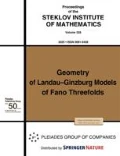Abstract
In modeling the dynamics of capital, the Ramsey equation coupled with the Cobb–Douglas production function is reduced to a linear differential equation by means of the Bernoulli substitution. This equation is used in the optimal growth problem with logarithmic preferences. The study deals with solving the corresponding infinite horizon optimal control problem. We consider a vector field of the Hamiltonian system in the Pontryagin maximum principle, taking into account control constraints. We prove the existence of two alternative steady states, depending on the constraints. This result enriches our understanding of the model analysis in the optimal control framework.
Similar content being viewed by others
References
F. P. Ramsey, “A mathematical theory of saving,” Econ. J. 38 (152), 543–559 (1928).
D. Acemoglu, Introduction to Modern Economic Growth (Princeton Univ. Press, Princeton, NJ, 2008).
L. S. Pontryagin, V. G. Boltyanskii, R. V. Gamkrelidze, and E. F. Mishchenko, The Mathematical Theory of Optimal Processes (Nauka, Moscow, 1969; Gordon and Breach, New York, 1986).
S. M. Aseev, K. O. Besov, and A. V. Kryazhimskii, “Infinite-horizon optimal control problems in economics,” Russ. Math. Surv. 67 (2), 195–253 (2012).
R. M. Solow, “Technical change and the aggregate production function,” Rev. Econ. Stat. 39 (3), 312–320 (1957).
W. T. Smith, “A closed form solution to the Ramsey model,” Contrib. Macroecon. 6 (1), 1–27 (2006).
S. M. Aseev and A. V. Kryazhimskii, “The Pontryagin maximum principle and optimal economic growth problems,” Proc. Steklov Inst. Math. 257, 1–255 (2007).
A. A. Krasovskii and A. M. Tarasyev, “Properties of Hamiltonian systems in the Pontryagin maximum principle for economic growth problems,” Proc. Steklov Inst. Math. 262, 121–138 (2008).
P. Hartman, Ordinary Differential Equations (Wiley, New York, 1964; Mir, Moscow, 1970).
Author information
Authors and Affiliations
Corresponding author
Additional information
Original Russian Text © A.A. Krasovskii, P.D. Lebedev, A.M.Tarasyev, 2016, published in Trudy Instituta Matematiki i Mekhaniki UrO RAN, 2016, Vol. 22, No. 3.
Rights and permissions
About this article
Cite this article
Krasovskii, A.A., Lebedev, P.D. & Tarasyev, A.M. Some Facts about the Ramsey Model. Proc. Steklov Inst. Math. 299 (Suppl 1), 123–131 (2017). https://doi.org/10.1134/S0081543817090152
Received:
Published:
Issue Date:
DOI: https://doi.org/10.1134/S0081543817090152


